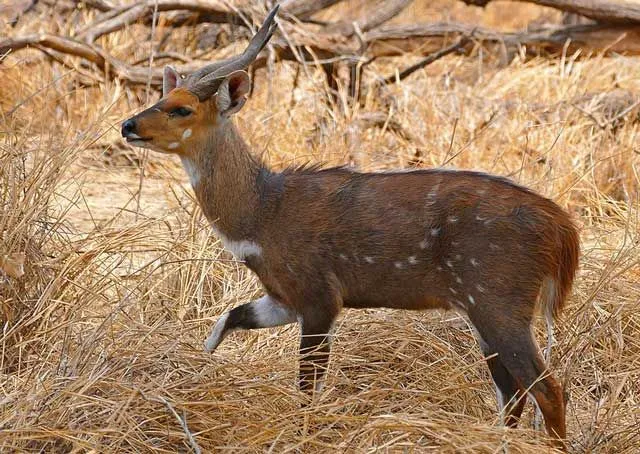
The bushbuck is an African antelope. It is prevalent in Sub-Saharan Africa and Eastern Africa. Bushbuck may be found in a variety of environments, including sub-deserts, rainforests, mountain forests, and savannas. Despite the fact that bushbuck can thrive in both wet and dry climates, it requires habitat that provides enough food and protection from predators. Bushbuck are threatened by habitat loss, which has already resulted in the extinction of some populations. Fortunately, bushbuck are still common in the wild and are not categorized as an endangered species.
Here are some interesting facts about bushbucks:
Bushbucks are known for their incredible leaping abilities. They can jump up to 6 feet (1.8 meters) in the air from a standing position. This helps them escape predators and navigate their environment.
Male bushbucks have a unique behavior where they will spray themselves with urine to attract females during the mating season. This behavior is thought to advertise their presence and dominance to potential mates.
Bushbucks are incredibly adaptable and can live in a wide variety of habitats, including forests, savannas, and swamps. This adaptability has helped them thrive in sub-Saharan Africa.
Despite their adaptability, bushbucks are highly susceptible to diseases such as rinderpest and anthrax, which can cause massive population declines. Conservation efforts are focused on protecting bushbucks from these threats.
Bushbucks are known for their ability to camouflage themselves in their environment. They have a reddish-brown coat with white spots and stripes that blend in with the surrounding vegetation. This helps them avoid predators.
In some cultures in Africa, bushbucks are considered to be a symbol of fertility and are often used in traditional medicine to treat infertility and other reproductive disorders. This is a reflection of the importance of bushbucks in African culture.
Bushbucks have a complex social structure and are known to form small groups consisting of a male and a few females. This social structure helps them protect themselves and their offspring from predators.
Despite their relative abundance, bushbucks are often hunted for their meat and hides, which can fetch a high price on the black market. Conservation efforts are focused on reducing hunting and poaching of bushbucks.
Bushbucks are known to be aggressive when cornered or threatened, and have been known to charge humans who get too close. This is a reminder that bushbucks are wild animals and should be treated with respect.
In addition to leaping, bushbucks are also strong swimmers and are able to cross rivers and other bodies of water when necessary. This adaptability helps them survive in different environments.
The scientific name for bushbucks is Tragelaphus scriptus, which means “marked goat-antelope.” This name reflects their physical characteristics and their place in the animal kingdom.
In some African cultures, bushbucks are associated with witchcraft and are considered to be sacred animals. Killing a bushbuck is believed to bring bad luck. This belief reflects the cultural significance of bushbucks in African society.
Bushbucks are primarily herbivores and feed on a variety of plants, including grasses, leaves, and fruit. This diet reflects their role in the ecosystem as grazers and browsers.
Bushbucks are preyed upon by a variety of predators, including lions, leopards, hyenas, and wild dogs. They rely on their speed and agility to avoid these predators. This is a reminder that bushbucks are an important part of the food chain in sub-Saharan Africa.
Bushbucks are not considered to be endangered, although habitat loss and hunting pose a threat to some populations. Conservation efforts are focused on protecting their habitat and reducing hunting and poaching.
In some parts of Africa, bushbucks are kept as pets or used for traditional hunting practices. However, these practices are becoming less common due to conservation efforts. This reflects the changing relationship between humans and bushbucks in Africa.
Bushbucks are known for their distinctive call, which sounds like a loud bark or cough. This call is used to communicate with other members of the group and to warn of potential danger. This vocalization is an important part of their communication and social behavior.
The average lifespan of a bushbuck in the wild is around 12 years. This lifespan can be influenced by a variety of factors, including predation, disease, and habitat quality.
Female bushbucks have a gestation period of around six months and typically give birth to a single offspring. This offspring is carefully protected by the mother and is often hidden in vegetation to avoid detection by predators.
Bushbucks are an important part of the ecosystem in sub-Saharan Africa, playing a key role in maintaining the balance between predators and prey. They help to control vegetation growth and provide a food source for a variety of predators, including lions, leopards, and hyenas. Conservation efforts are focused on protecting bushbucks and other species in the region to maintain the delicate balance of the ecosystem.








